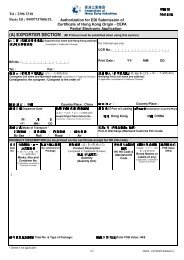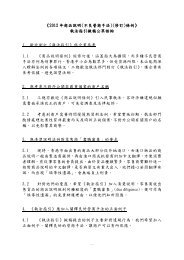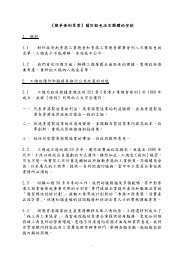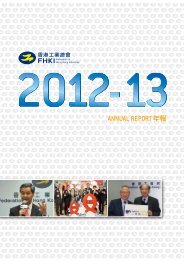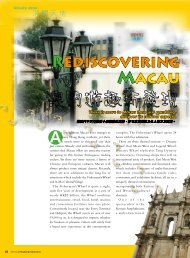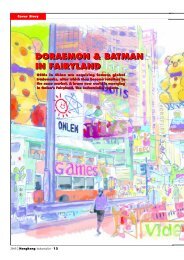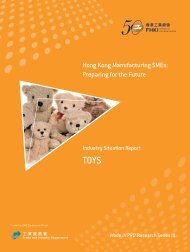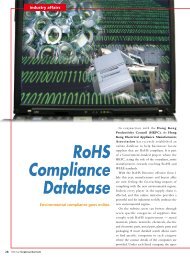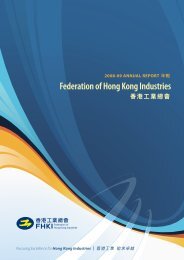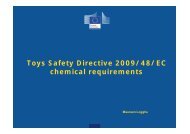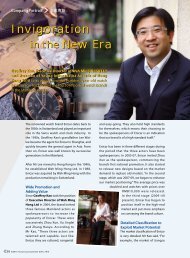Hong Kong Manufacturing SMEs: Preparing for the Future
Hong Kong Manufacturing SMEs: Preparing for the Future
Hong Kong Manufacturing SMEs: Preparing for the Future
- No tags were found...
Create successful ePaper yourself
Turn your PDF publications into a flip-book with our unique Google optimized e-Paper software.
21demand and production (such as industries inwhich a large portion of sales are made <strong>for</strong> <strong>the</strong>Christmas period). The overtime limits were alsoviewed as problematic, since workers wanted towork more overtime to earn more money. Somemanagers indicated <strong>the</strong>y knew of cases in whichcompanies offered unpaid voluntary work onSaturdays and <strong>the</strong>n separately paid workers a bonusto compensate. It was reported that companies thatdid not engage in such practices could lose workersto companies that allowed <strong>the</strong> workers to effectivelywork more overtime and earn more money. Severalinterviewees claimed that companies that did notfind a way around some of <strong>the</strong> labour regulationsare at a competitive disadvantage versus Mainlandcompanies and o<strong>the</strong>rs that ignore or stretch <strong>the</strong>law. Some interviewees wondered how <strong>the</strong>irown companies could survive alongside Chinesemanufacturing firms that operate in <strong>the</strong> same placeand compete in <strong>the</strong> same markets but have <strong>the</strong>ability to avoid some costs or regulations. The Law isalso seen as compounding <strong>the</strong> problems of findingworkers and escalating wages that have hit <strong>the</strong>garments, toys, and electronics sectors particularlyhard. 43Environmental and Safety RegulationsChina as a whole has suffered from significantenvironmental degradation associated with itsindustrial development. According to <strong>the</strong> WorldBank, China is home to 16 of <strong>the</strong> world’s 20 mostpolluted cities. The Pearl River Delta has also beenaffected by pollution. Guangdong has historicallybeen considered a laggard in environmentalprotection in China and several of its cities, mostnotably Dongguan, Foshan, and Guangzhou,have air quality that is poor even by Chinesestandards. In 2008, over 90 per cent of <strong>the</strong> citiesin Guangdong Province had an acid rain problem,and nine cities including Guangzhou, Shenzhen,Foshan, Jiangmen, Maoming, Zhaoqing, Huizhou,Dongguan, and Zhongshan, most of which arelocated in <strong>the</strong> PRD, are considered to be severelypolluted by acid rain. 44 In addition, in 2008, only 53per cent of Guangdong’s waste water was properlytreated. Ef<strong>for</strong>ts to address environmental concernsare improving in Guangdong, albeit slowly. In 2008,RMB 4.7 billion, or 1.4 per cent of fiscal revenuein <strong>the</strong> province was invested in environmentalprotection, compared to RMB 2.64 billion (0.95 percent of fiscal revenue) in 2007. 45In 2006, <strong>the</strong> Guangdong Government announced anEnvironmental Protection Initiative that targeted <strong>the</strong>chemical, petrochemical, smelting, electroplating,tanning, printing and dyeing, cement, papermaking,nuclear and radioactive, and hazardous wastetreatment industries. Environmental impactassessments were also expected to become tougheron polluting facilities. In 2006, 150,000 factoriesin Guangdong were inspected <strong>for</strong> pollution androughly 2,100 were closed down. 46 Guangdong hasset up strict guidelines <strong>for</strong> polluting industries tomove to “eco industrial parks” specially designedto accommodate and deal with effluents. Foshanhas been designated as an “environmentaldemonstration city”, while Dongguan is seeking thisstatus. In <strong>the</strong> first 10 months of 2006, Shenzhenofficials claimed to have refused permission orcaused to move from Bao’an District 1,260 firmsdue to environmental and energy consumptionconcerns. 47 In 2008, Dongguan officials claimed tohave shut down 173 factories that did not meetenvironmental standards, involving electroplating,printing and dyeing, paper making, and tanning.Additionally, more than 600 firms considered ashighly polluting were targeted <strong>for</strong> movement todesignated locations. 4843 ESA Project Interview, 2010-04-07.44 Gazette of Environment Situation in Guangdong Province2008.45 Guangdong Statistical Yearbook 2009, p.184. GuangdongEnvironmental Protection Bureau. www.gdepb.gov.cn.46 Ivan Zhai, “2,000 polluting factories shut down,” South ChinaMorning Post, 7 February 2007.47 “Shenzhen keeps 1,300 firms out of city,” China Daily, 29November 2006.48 “Dongguan Shut down 173 Highly Polluting Factories,”Guangdong Environmental Protection Bureau, May 28, 2008.www.gdepb.gov.cn.



